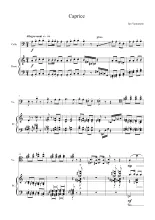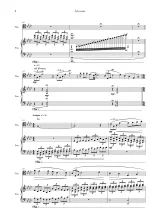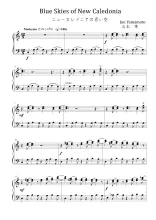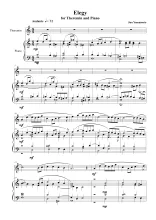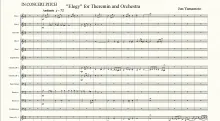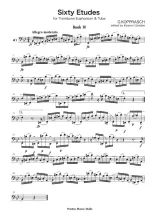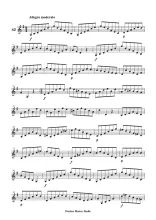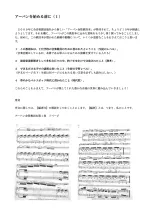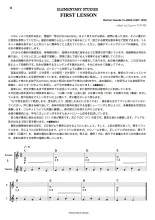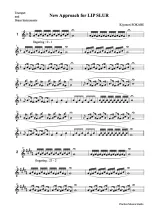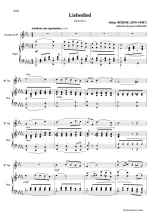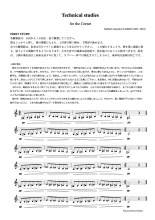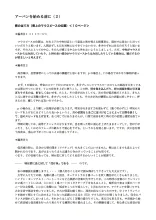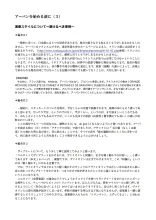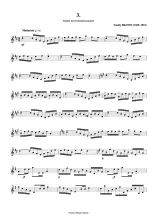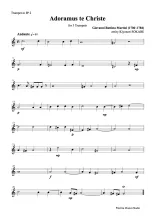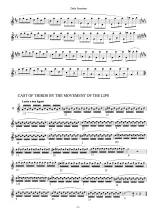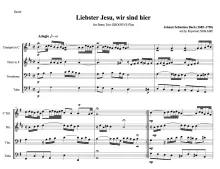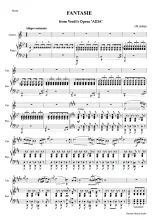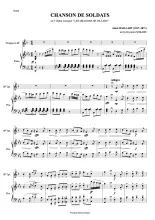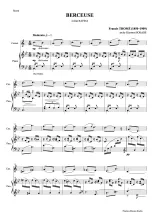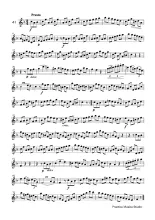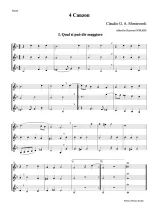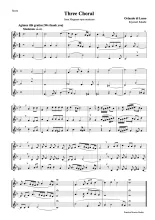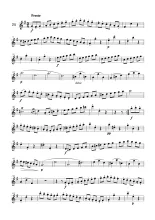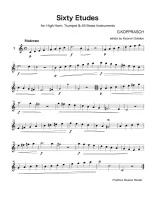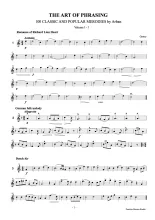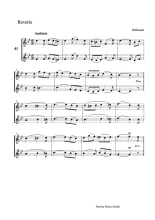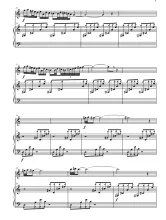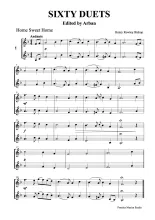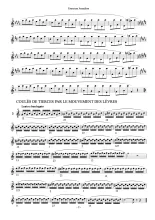New Releases
Our Staff Picks
News
60 Etudes for high part by Kopprasch vol.3
KOPPRASCH, Georg (arr. SOKABE, Kiyonori)ゲオルク・コプラッシュ(arr. 曽我部清典)
元は、ホルンの高音奏者のために作られました。トランペットやユーフォニアムでも演奏可能です。
4 Canzon
MONTEVERDI, Claudio G. A. (arr. SOKABE, Kiyonori)クラウディオ・モンテヴェルディ(arr. 曽我部清典)
トランペット三重奏のために編曲しました。コンサートの他に、ハーモニーの練習として、使って下さい。
Three Chorals
LASSO, Orlando di (arr. SOKABE, Kiyonori)オルランド・ディ・ラッソ(arr. 曽我部清典)
トランペット三重奏のために編曲しました。コンサートの他に、ハーモニーの練習として、使って下さい。
New Approach for Lip-slur
SOKABE, Kiyonori曽我部清典
New Approach for Lip-slur
リップスラーの際、倍音を越える時、壁を感じている人のための、間に一つ音を挟むことで壁を越え易くなるような練習曲です。私のメソッドのno.3~4からリップスラーに移行するやり方です。http://www.jade.dti.ne.jp/~ebakos/warmup/play1.html
60 Etudes for high part by Kopprasch vol.2
KOPPRASCH, Georg (arr. SOKABE, Kiyonori)ゲオルク・コプラッシュ(arr. 曽我部清典)
元は、ホルンの高音奏者のために作られました。トランペットやユーフォニアムでも演奏可能です。
60 Etudes for high part by Kopprasch vol.1
KOPPRASCH, Georg (arr. SOKABE, Kiyonori)ゲオルク・コプラッシュ(arr. 曽我部清典)
元は、ホルンの高音奏者のために作られました。トランペットやユーフォニアムでも演奏可能です。
Art of Phrasing vol.1-1
Various Composers (arr. ARBAN, Joseph Jean-Baptiste Laurent)様々な作曲家(arr. ジョセフ・ジャンバティスト・ローラン・アルバン)
アーバンのオリジナルはコルネットでしたが、使用楽器はトランペットとしてあります。もちろん、コルネットやフリューゲルホルンなど他の金管楽器でも演奏できます。
60 Duets vol.3 by Arban (41~60)
Various Composers (arr. ARBAN, Joseph Jean-Baptiste Laurent)様々な作曲家(arr. ジョセフ・ジャンバティスト・ローラン・アルバン)
アーバン監修によるデュエット集です。全音楽譜からのアーバンがリニューアルした際に割愛されたものと同じではなく、アーバン自身が作成したものです。
Un Piccolo Divertimento (Dizi, Yangquin)
YAMAMOTO, Jun山本準
The composer had been amazed to listen and come to know the splendid musical capability of Dizi and Yangquin, demonstrated by Mr. Mingjun Wang and Ms. Min Lin in the summer 2017, of course, owing to the virtuosity of the two fabulous musicians. Dizi can run through very fast passages very lightly and precisely, and play slower melodies much expressively. Yangquin is maintaining its traditional characteristics of the instrument and can freely jump around, or expressively play tremolos (which is very much characteristic of the instrument) on the chromatic scale over full 4 octaves. I tried to fully take advantage of those amazing capabilities of the instruments, and make the music as much as delightful for the listeners.
Though it is a short piece with divertimento character, it consists of roughly 5 parts, i.e. Introduction, Exposition, Yangqin Cadenza, Recapitulation, and Development/Coda. It is a kind of a compacted sonata form with some twist. Introduction starts with ad libtum performance of Yangqin and it introduce the basic four-note motif for the entire composition, i.e. “d-fis-c-f”. In Exposition, Dizi plays the rhythmic first subject over the ostinato of 16-note figure by Yangqin. As Dizi is basically a D major-instrument, the major part of Exposition is based on F# Phrygian. The second subject is slower and based on the “d-fis-c-f” motif. Yangqin extends the tonal feeling from D major toward a multi tonal space. Then a short cadenza by Yangqin follows. Capitalizing the instrument’s 12-tone ability, the music develops freely in the 12-tone system. The Recapitulation is based on roughly A Mixolydian and the first subject appears in a variation form in Dizi. The last part is coda but it has in the same time characteristics of Development of the first subject and the basic motif of “d-fis-c-f”.
The composition premiered as a tentative version by O Mei-kun (Dizi) and Guo Min (Yangqin), on March 9, 2018, at “JFC Asian Traditional, Asian Contemporary”, in Tokyo, Japan, and premiered in the full version by Sham Kin-yu Kenneth (Dizi), Kwok Kaying (Yangqin) on May 31, 2018, “Aisan Tradition, Asian Contemporary”, in Hong Kong
王明君氏・林敏氏の笛子と揚琴のデモンストレーションを拝聴して、その表現力の幅広さに驚かされた。笛子は速いパッセージは軽快に、ゆっくりした表現は情感たっぷりに演奏することができ、一方揚琴は、伝統的な響きを残しながらなんと4オクターブにわたる西洋的な半音音階を縦横無尽、融通無碍に演奏することができる。この曲ではそれらの各楽器の能力をできる限り活かし、聴いて楽しい音楽になるように努めたつもりである。
短い喜遊曲ではあるが、5つの部分から構成された変形ソナタ形式である。導入部において、揚琴により基本テーマとなるd fis c f の音形が導入される。第一主題は揚琴の16分音符のオスティナート上で笛子によりリズミカルに演奏される。笛子が基本的にニ長調の楽器であることから、第一主題はF#フリジアンによる。続いて第二主題は基本テーマのd fis c fの音形を展開していく。揚琴の12音平均律を演奏できる能力を活かして、続く揚琴によるカデンツァでは調性は拡大されていく。再現部はAミクソリディアンにより、第一主題、第二主題の順に回帰する。終結部は基本テーマであるd fis c fの音形による展開部を兼ねて、速度を上げて終結する。
本作品は暫定版として、2018年3月9日に王明君(笛子)郭敏(揚琴)の両氏によって東京にて初演され、同年5月31日に香港で、“Aisan Tradition, Asian Contemporary”において、沈健楡(笛子)郭嘉瑩(揚琴)の両氏により完全版の初演が行われた。
60 Duets vol.2 by Arban (21~40)
Various Composers (arr. ARBAN, Joseph Jean-Baptiste Laurent)様々な作曲家(arr. ジョセフ・ジャンバティスト・ローラン・アルバン)
アーバン監修によるデュエット集です。全音楽譜からのアーバンがリニューアルした際に割愛されたものと同じではなく、アーバン自身が作成したものです。ト音記号が読める楽器であれば、どんな楽器でも演奏できます。
60 Duets vol.1 by Arban (1~20)
Various Composers (arr. ARBAN, Joseph Jean-Baptiste Laurent)様々な作曲家(arr. ジョセフ・ジャンバティスト・ローラン・アルバン)
アーバン監修によるデュエット集です。全音楽譜からのアーバンがリニューアルした際に割愛されたものと同じではなく、アーバン自身が作成したものです。
Exercises Journaliers
ARBAN, Joseph Jean-Baptiste Laurent (arr. SOKABE, Kiyonori)ジョセフ・ジャンバティスト・ローラン・アルバン(arr. 曽我部清典)
アーバンが推奨する毎日の練習曲フランス語版(原典版)です。
